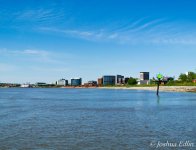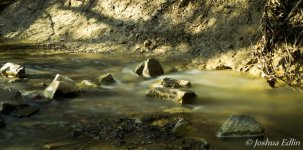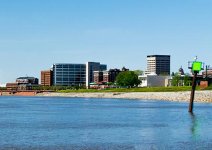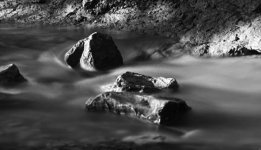First it is great to see you are getting out and just shooting what you think is interesting. That being said, and based on your two photos, I would think carefully about a scene in terms of what is the center of attention and where would you like the viewer's eyes to be directed to first. What is it about the scene that first grabs your attention? I would ask yourself that. Now I agree that even though the first one is a landscape, the 28 mm takes in too much of the water and the sky. The buildings make for a nice skyline but they are too far away. I would use even a short telephoto for this scene so that the buildings and landscape make up 2/3rds of the image and the sky and water make up the remaining third.
So for the stream image, it is commendable that you attempted to get a flowing effect with the longer exposure. But actually, even just 2-5 seconds would have been fine. Also I think that the long exposure has shifted the color a bit which is common with some sensors, so that would be another reason to stay away from too long an exposure. Going back to the question of center of interest, I see rocks and water and a shore and some foreground, but there isn't really a center of attention, apart from perhaps the pyramid-shaped rock dead center in the frame. That rock is interesting, but it is dead center which renders it a bit less interesting, because the eye goes to it, then the water flows around it like it is an obstacle. What would be better is that it is off to the left a bit on the 2/3rd line and then the water flows down from that center of interest. Also, we think of water flowing down a stream. So I would have shot down toward the stream a bit with the stream going to a diagonal with respect to the frame to enhance the impression of flowing down. As it is shot, the stream flows perfectly horizontally across the frame, which doesn't give the flow the same kind of weight.
In a nutshell, often we look at a scene and expect then to photograph it as we see it, just because it would seem natural that that is how we should photograph it, as it is. However, the art in photography is being able to find within the scene a story, or what about the scene communicates something beyond what the subject matter really is when one just walks casually past it. If someone were to paint the same scenes, yes they would probably try to make it look the same as the scene, but for a photographer it is more of a challenge to render the scene in some way apart from what we normally would see to give it an identity of its own, to lend a personal style to the image. Every image you take from now on has to convey something of your own personal style and you should ask yourself "Can I photograph this in a way that reflects what I want to see in the scene?". If you are confident that you can, then proceed. If you are not confident or if the subject just isn't "cooperating", then leave it and move onto the next subject.







